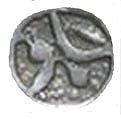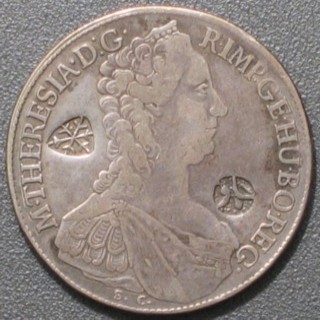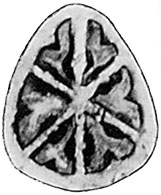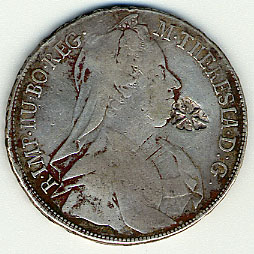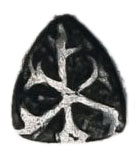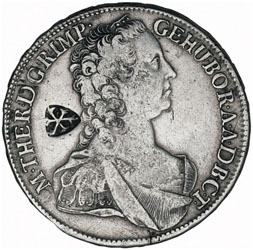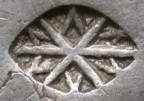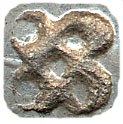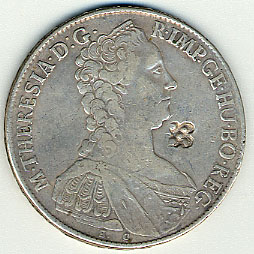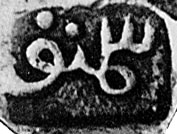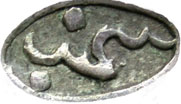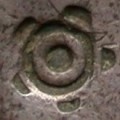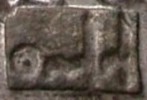
Java is one of the major Indonesian islands. Madura is a much smaller island located on the eastern tip of Java. Soumenep is one of the larger cities on Madura. From the early 19th century to the Japanese invasion in 1942, both islands were Dutch colonies, known as Netherlands East Indies.
Java
Research
When Java was part of Netherlands East Indies, the Dutch government oficially applied a round countermark with Arabic "Djawa" (=Java) to milled Dutch ducats (Scholten, Coins of the Dutch Overseas Territories, pg. 60, 61). This countermark was introduced by Resolution of 13 December 1753. By order of the home authorities of the Company the stamping of the Ducats was stopped in accordance with the Resolution of 4 September 1761.In the Fonrobert auction, a half Gold Rider of Overyssel 1760 with countermark "Jawa" is listed as #367. The present whereabouts of this piece is unknown. No official records exist concerning the counterstamping of this type of coin. The genuineness of this stamp is therefore questionable (ref. Scholten., pg. 58).
A similar counterstamp was used to countermark Persian Rupees. A resolution or placard by which this type of countermarkes coins was put into circulation is not known, but in a resolution of Oct. 2, 1758, it is declared that the stamp for the Persian Rupees was no longer in use. In 1760, a decision was made to withdraw all countermarked Batavian, Surat, and Persian Rupees for 30 Stivers apiece and reissue them at a rate of 27 Stivers. From the known authentic specimen it can be seen that they are extremely rare and that they were freshly imported items when they were counterstamped. Date range for the known specimen is approximately 1745-1750.
The "Jawa" countermark is also found on Maria Theresa Thalers and on Mexican Reales.
It is listed as J1 below.
J1 was seen on older (pre-1780) Maria Theresa Talers in a number of coin auctions,
often together with the Madura Star (S1a/b, see below).
It is unlisted in the Hafner catalog.
Specimen
The March 1968 auction of Hans Schulman lists as lot #1430: ' JAVA. Maria Theresa Taler 1780 SF, ctstpd. with round stamp "star"'. This might refer to counterstamp S6 below, to Hafner 106, which is commonly attributed to Ethopia, or to Hafner 132 (Mukalla). Since there is no photo, this is just a wild guess.
Conclusion
The status of Java counterstamps on Maria Theresa Thalers is questionable. There is no known historic reference indicating that the counterstamp was ever officially applied to non-Dutch coins. Also, if the counterstamp was applied in the 19th century or in the late 18th century, one should think that it would have been offered in coin auctions before 1968. However, I have been unable to locate a sale earlier than 1968.Numismatists today believe that the Java counterstamp was applied to Maria Theresa Talers, Real Batoe, and other Talers at a later time to "fulfil collectors' demands".
Soumenep (Sumanap, Soumanap, Sumenep, Sumanep)
Early Countermarks
The first countermark commonly attributed to Sumanep is the square or rectangular countermark with Sumanep in Malay Arabic (S3).
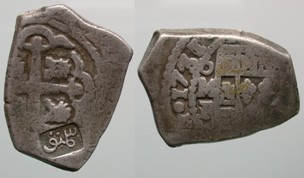
|
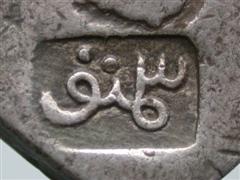
|
|
4 Real 1731 with countermark Sumanep in Malay Arabic |
|
This countermark is found on Spanish-American Pieces of Eight (8 Reales) and its denominations, dated 1729 - 1732.
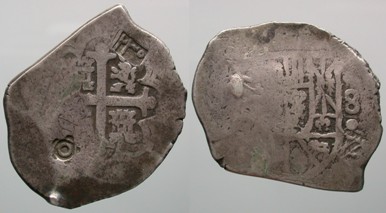
|
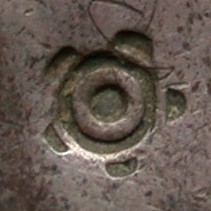
|
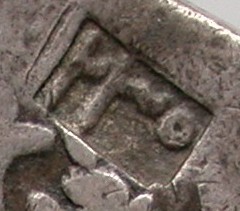
|
|
Real Batoe with countermarks flower and (1)230 |
||
Other countermarks such as a flower (S7) and/or the Arabic number (1)230 (S8) are sometimes seen with the Sumanep countermark described above and thus also attributed to Sumanep.
The Madura Star
The countermark most commonly associated with Soumenep is the Madura Star (Hafner 115, shown as S1a/b below). Two variants of this countermark exist. The first is a shield-like countermark with a lily-cross, as shown in the following picture.
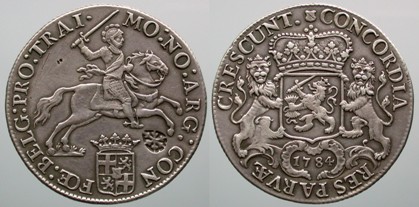
|
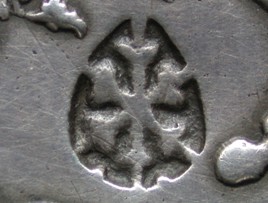
|
| Ducaton Utrecht 1784 with countermark shield/lily/cross | |
This countermark is found on large silver pieces, like Ducatons, Maria Theresa Thalers, and milled Spanish Eight-Real pieces. This countermark is mainly found on coins dated from the second half of the 18th century. It is commonly attributed to the rule of Sultan Paku (Pakoe) Nata Ningrat, but this is not confirmed. Multiple variants of this counterstamp are known to exist.
This counterstamp is first attributed to Soumenep in the Fonrobert collection (Lot 759; the text refers to Netscher & v.d. Chijs page 159). Later references appear to follow this classification.
The second variant of the Madura Star is in the shape of a pointed oval with a flower-like design (S1d). This countermark is mainly applied on Rupee-sized coins, such as silver rupees (maily from Java), Gerneraliteits-guilders, Quarter Pagoda of British India, and Spanish 4 Real.
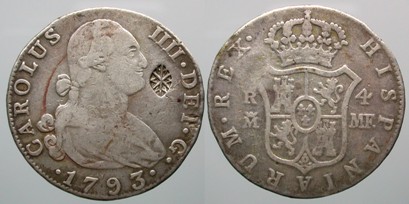
|
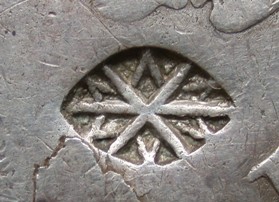
|
| 4 Real 1793 with shield/flower countermark | |
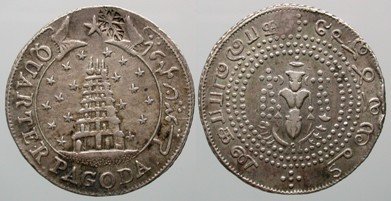
|
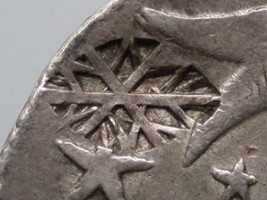
|
| BEIC Pagoda 1807 with shield/flower countermark | |
This countermark, which is the most common of all, is mainly found on coins from the second half of the 18th century and the early 19th century. According to Netscher and Van der Chijs, Sultan Paku (Pakoe) Nata Ningrit (Ningrat) (1812-1854) installed in 1818/19 a commission for countermarking silver money. This was supposed to suppress the many counterfeit coins in circulation. Subsequently, silver coins were countermarked with a flower. Jan Lingen suggests that this is probably the second variant of the Madura Star as shown above (S1d). According to Lingen, the countermark on the 4 Real displayed above is genuine, while the authenticy of the countermark on the Pagoda is questionable.
After this countermark was imitated, the countermark die was changed for one with the word Sumanep in Arabic. This occurred around 1820. Lingen believes that this is probably the countermark with Sumaneb in an oval (S4a).
Countermarking of coins in Sumanep was stopped around 1825.
An interesting comment about counterstamps in the
Fonrobert collection is on Forging of Danish West
Indian counterstamps:
Fonrobert's
catalogue (Berlin 1878), edited by Adolph Weyl, has until now been seen
as the authoritative bible on American coins. However, it is clear that
the collection contains hoards of forged counterstamps, probably all
manufactured in Germany.
According to the web site author, this comment primarily refers to Danish West India counterstamps in the Fonrobert collection.
The Madura Star is found on older (pre-1780) Maria Theresa Talers, sometimes together with the Java counterstamp. Various specimen have been offered in several coin auctions.
- Hans Schulman, March 1968 auction, #1432. Host coin is a 1765
Guenzburg taler (S1a).
- Hans Schulman, May 1969
auction, #819. Host coin is a 1752 Maria Theresa Taler (J1, S1a).
- Hans Schulman, May 1969 auction, #820. Host coin is a 1758 Maria Theresa Taler (S1a).
- Hans Schulman, May 1969 auction, #821. Host coin is a 1780 Maria Theresa Taler; from Browder collection. The host coin appears to be a post-1945 strike, thus this is probably a fake (S1a).
- Hans Schulman, November 1971 auction, #1840. Host coin is a 1765 Maria Theresa Taler (S1a).
- Swiss Bank Corporation, January 1998 auction, #1431. Host coin is
a 1772 Hall taler (S1b).
- UBS auction September 16, 2004, #3194. Host coin is a 1765 Guenzburg taler (J1, S1a).
- Heritage Coin auction, September 10, 2004 (sale 357), #14227. Host coin is a 1767 Vienna taler (S1a).
- Stack's Coin Galleries, July 20, 2005, #864. Host coin is a 1763 Kremnitz taler (S1c).
Counterstamp S1b, together with J1, is on a Maria Theresa Taler in Bernard Olij's collection. Host coin is a 1765 Guenzburg Taler.
Broome has the following comment about Sumenep counterstamps on Maria Theresia Talers.
The second of the countermarks attributed to Sumenep is one which consists of an emblem rather like three crossed arrows in a shield-shaped or oval depression. This is said to be the badge of the Sultan Paku Nata Nigrat, and is dated ca. 1854. So far, it has been seen on coins dated 1765 to 1805 only, including Maria Theresia talers of Gunzburg mint of 1765 and probably Vienna mint of 1766. No evidence has been quoted to support this attribution, which may be based on a misreading of the relevant Dutch text by the cataloguer of the Fonroberts Collection. [...]
Another interesting comment regarding the Madura Star was found on World Exonumia in Mail Bid Sale 11:
Other counterstamps attributed to Soumenep
Counterstamp S2 is on a on a 1765 Maria Theresa Taler in my collection. This counterstamp was attributed to Soumenep by the seller and is supposedly listed in KM as KM-199.3. However, the 3rd edition of KM World Coins associates Madura, KM-199.3, with a Madura Star countermark. Therefore, the attribution of this countermark with Soumenep can not be confirmed, and the origin of this counterstamp has to be considered unknown. Lingen agrees, saying that S2 may have been countermarked at any place.
An early reference to a Soumenep counterstamp on a Maria Theresa Thaler can be found in Cabinet des Monnaies. This sale lists two Maria Theresa Thalers with Soumenep counterstamp as follows.
Monnaies contremarqueés par de la prince Pakou Nata Ningrat, ?-1270 (A.D. 1854)
b. Incuse ovale, avec la contremarque: Soumanap
| 5778 | Thaler hongrois de Marie Thérèse, de 1754 (Schultesz, 2558). |
| 5781 | Thaler tyrolien de Marie Thérèse, de 1780. (Schultesz, 502). |
This sale is referred to in The Numismatist, January 1944, "More Questions about the Maria Theresa (Levant) Thaler", as follows:
This possibly refers to the counterstamp shown as S4a/S4b below, which is currently unlisted in the Hafner catalog. However, no Maria Theresa Thaler with this counterstamp is currently confirmed to exist.
Counterstamp S4a was seen on a Dutch Guilder on Zeno - Oriental Coins Database, coin number 23979. The description is follows.
Mr. Lingen, who created the entry on Zeno, provided the following additional information:
Netscher & v.d. Chijs on page 159 describe the sq. c/m on a Real-Batoe (Spanish Real) as "...belandjar with Arabic or Malayan symbols, which in correct Malay should be belandja." This might be the origin of the "belandjar" translation, however the correct reading on the Spanish Real and the Dutch Generaliteits-guilder in May-Arabic is different.
The sq. countermark on the Real-Batoe (Stone real) reads "Sumanep" in Malay-Arabic and is found on Spanish 8 and 4 real pieces, dated 1729-1732. The c/m in oval as illustrated by me reads "Sumaneb".
All the countermarks which read Banjar in oval are regarded as not authentic! The Malay-Arabic inscription doesn't mean anything. No way you can read Balanjar or belanja (There is no "Lam" after the "Be". With some imagination you may read it as Banjar (or Bandjar = Dutch pronunciation) and than the resemblance with Bandjarmasin is than of course striking. However, no reference, either by Netcher & v.d. Chijs, nor Millies, have ever been made of such countermarking at Bandjarmasin. Therefore it is at the moment generally accepted by Dutch numismatists that they are clear copies from the published "Sumaneb" c/m. This view is also written down in the Dutch Encyclopaedia of Coins and Paper-money, p. S-154-155.
It was not uncommon to make all kind of fantasy c/m's to satisfy the collectors demand. Most probably the coins with the Banjar c/m are copied after the illustration in Netscher v.d. Chijs (1864) and as such came into the Fonrobert's collection (Auctioned 1879).
Furthermore, the lots 870 and 871 in the Fonrobert collection were coins struck for the West-Indies (both dated 1794), and it is very unlikely that they have circulated in the East.
Counterstamp S5 was seen in Baldwin Hong Kong Auction 40, September 2005, lot 1159, with the following description.
This counterstamp was attributed to Sumatra in a presentation about counterstamps, with no further explanation.
Counterstamp S6 was seen in Baldwin New York Auction IX/X, January 2005, lot 272, with the following description.
Acknowledgements
Many thanks to Bernard Olij and Jan Lingen for providing valuable information about Java and Soumenep counterstamps.
